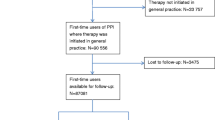Abstract.
Objectives: (1) To determine the extent to which Australian general practitioners (GPs) restrict the numbers of agents they prescribe within a drug class ('personal formularies'); (2) To assess concordance of these drug choices with standards based on established guidelines or recognised good prescribing practices; (3) To assess the potential of these measures as indicators of the quality of prescribing. Methods: Australian Health Insurance Commission (HIC) prescription data (1994–1997) for around 15,400 GPs providing 1500 or more Medicare services per year were analysed. Measures of an individual GP's use of a personal formulary (determined by number of agents) and concordance with prescribing criteria based on specified drugs for five classes of commonly prescribed drugs were derived. Results: Non-steroidal anti-inflammatory drugs (NSAIDs): GP concordance was higher with a non-specified personal formulary (any five NSAIDs) than with a list of specified drugs (five NSAIDs of 'low' or 'medium' risk of gastrointestinal toxicity), and concordance with both increased over time. In 1997, around 70% of GPs used five or fewer NSAIDs for 90% of their prescribing; 47% of GPs had 90% of prescribing from five selected agents. Angiotensin converting enzyme inhibitors/angiotensin-II receptor antagonists: The introduction of new agents appeared to increase the size of the GPs' personal formularies, and concordance with defined standards decreased over time. Antibacterial agents: Concordance with a specified drug standard (nine drugs listed in the Australian Antibiotic Guidelines) increased substantially over time but was largely due to increased prescribing of two heavily promoted drugs. Beta-blocking agents: Over time, GPs restricted most prescribing to two agents, atenolol and metoprolol. Calcium channel blockers: GPs did not appear to restrict prescribing of these drugs; most GPs prescribed all five agents available. Conclusions: Australian GPs use 'personal formularies'. Formulary size varies with the drug class, can change over time as new agents become available, and its contents can be influenced by promotional activities. Prescribing standards based on numbers of drugs used may not always reflect rational prescribing choices. Criteria based on specified drugs provide more rigorous prescribing standards, but may give a misleading picture of prescribing quality in the absence of information on patients and the indications for treatment. Personal formulary measures are potentially useful prescribing indicators but need to be carefully defined and interpreted. GPs should be encouraged to identify their personal formularies and review the drugs included in them.
Similar content being viewed by others
Author information
Authors and Affiliations
Additional information
Accepted in revised form: 19 April 2001
Electronic Publication
Rights and permissions
About this article
Cite this article
Robertson, J., Fryer, J.L., O'Connell, D.L. et al. Personal formularies. Eur J Clin Pharmacol 57, 333–341 (2001). https://doi.org/10.1007/s002280100310
Received:
Issue Date:
DOI: https://doi.org/10.1007/s002280100310




